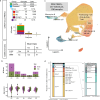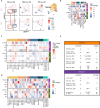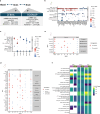A single-cell atlas to map sex-specific gene-expression changes in blood upon neurodegeneration
- PMID: 40000636
- PMCID: PMC11862118
- DOI: 10.1038/s41467-025-56833-7
A single-cell atlas to map sex-specific gene-expression changes in blood upon neurodegeneration
Abstract
The clinical course and treatment of neurodegenerative disease are complicated by immune-system interference and chronic inflammatory processes, which remain incompletely understood. Mapping immune signatures in larger human cohorts through single-cell gene expression profiling supports our understanding of observed peripheral changes in neurodegeneration. Here, we employ single-cell gene expression profiling of over 909k peripheral blood mononuclear cells (PBMCs) from 121 healthy individuals, 48 patients with mild cognitive impairment (MCI), 46 with Parkinson's disease (PD), 27 with Alzheimer's disease (AD), and 15 with both PD and MCI. The dataset is interactively accessible through a freely available website ( https://www.ccb.uni-saarland.de/adrcsc ). In this work, we identify disease-associated changes in blood cell type composition and the gene expression in a sex-specific manner, offering insights into peripheral and solid tissue signatures in AD and PD.
© 2025. The Author(s).
Conflict of interest statement
Competing interests: A.K. was advisor of the company Firalis, researching RNA-based biomarkers for AD, while preparing the manuscript. C.L., Q.S., Y.L., C.C., Y.Y., J.X., M.J., Z.W., T.W., L.L., and Y.H. work for the company MGI group while working on the project. The remaining authors declare no competing interests.
Figures





References
MeSH terms
Grants and funding
LinkOut - more resources
Full Text Sources
Medical

